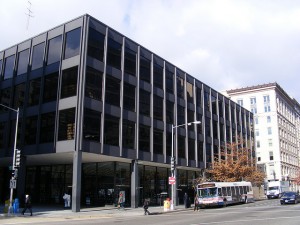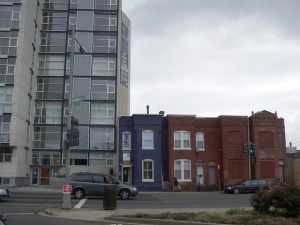
Flickr: Paul Simpson
Martin Luther King, Jr. Memorial Library will close during a federal government shutdown.
A federal government shutdown will do more than impact federal employees (and their BlackBerrys) — many D.C. residents, including the District’s most vulnerable residents, will feel the pain.
Residents lacking a computer or access to high-speed Internet won’t be able to rely upon their local library to cross the digital divide. Public and charter schools will remain open, so students should probably take advantage of the Internet access they can get at their schools — unless you attend the University of the District of Columbia, which will be closed.
Folks who rely on the Circulator buses to get to work will have to hop on a Metrobus instead (bright side: Metro cars could be a lot less crowded!).
But many basic services would continue, including Temporary Assistance to Needy Families, food stamps and Medicaid. United Medical Center and St. Elizabeth’s hospitals will remain open, and firefighters and police officers will continue to work. Other services will be limited, including unemployment benefits. Mayor Vincent Gray announced that non-essential employees likely won’t be working: about 14,000 of the District’s 35,000 municipal employees would be furloughed under the D.C. plan [PDF].
Continue reading →
Good morning, DCentric readers, and I hope all of you are thoroughly enjoying D.C. services while you still can. Here are your tasty morning bytes:
Many D.C. agencies would close under federal shutdown, mayor says If it happens, don’t count on having your trash collected, your car inspected or being able to go to the library. Oh, what’s that, you don’t have the luxury of having your own computer with a high-speed connection? Some services that would continue to operate include the school system, emergency medical services, medicaid and food stamps. “[Mayor] Gray sharply lamented the fact that the federal government’s shutdown would affect the District, whose budget is mostly composed of locally raised funds. ‘This is not an abstraction,’ he said. ‘This is a concrete example of what it means to be treated as a second-class citizen.’” (The Washington Post)
7 Shot, 4 Dead After Violent Night in D.C. Really sad news from Northwest, Northeast and Southeast: a string of shootings and stabbings last night leave seven injured and four dead. “Police have not connected the incidents, no arrests have been made and there is very little suspect information.” (NBC4)
It Really Is Better Now For Blacks A reminder: things were really a lot worse 100 years ago than they are now. “… over the past couple of weeks, we have heard some grim takes on the fact that so many black people have moved back to the South over the past 10 years. Walter Russell Mead blogs that the North was unable to provide us a haven, while the University of Pennsylvania’s Thomas Sugrue is unhappy that blacks leaving Detroit are moving to the less tony inner-ring suburbs rather than the opulent ones. To me, what’s significant is that black people can move, period.” (The Root)
Report: Apartment Vacancy Drops Across Country And here in D.C., the vacancy rate is even lower than the national average, and high-end new apartment construction continues. “The Delta report stated that DC-proper vacancy levels for Class A and B apartments were at 3.8 percent at the end of 2010, and that the market was even tighter in submarkets like Columbia Heights/Shaw where vacancy was at 2.8 percent.” (UrbanTurf)
Continue reading →

Flickr: Daniel Lobo
Just how rich are the rich? Americans are totally off-the-mark when answering that question, at least according to a recent study [PDF], which found that although the top fifth richest Americans own 85 percent of the country’s wealth, many Americans thought that figure was closer to 59 percent.
Make no mistake, in D.C., the disparities between the rich and poor are severe and were only made worse by the recession: in 2009, median household incomes in parts of Wards 2, 6 and 1 rose significantly but dropped East of the River, and 11 percent of D.C. residents were living in deep poverty, on less than $11,000 for a family of four.
Those are the facts, but just as important is how we frame the disparities between rich and poor. In an opinion piece that ran Monday in The Christian Science Monitor entitled “Do you think the poor are lazy?” (that’s some headline, by the way), Anat Shenker-Osorio writes about the wealth study and the role language plays in our perception of wealth inequality:
Continue reading →
It’s not raining and the federal government hasn’t shut down yet — it’s a good morning, no? Here are some links to help you start your day:
African American Civil War Museum Moves into Awesome New Building The museum moved from a small space at 1200 U St., NW to a much larger location at 1925 Vermont Ave., NW. “Founding Director (and former Council Member) Frank Smith tells me that by next weekend about 65% of the exhibits would be installed.” (Prince of Petworth)
Today in D.C. History: Rioting Spreads Following MLK’s Assassination A look back at the D.C. riots that left the city in ruins for years to come. “One business that did escape the burnings, however, was the Giant supermarket chain. Joseph Danzansky , Giant’s chairman, had been active in working with emerging African American community organizations (including Pride, led by activist Marion Barry .) Danzansky had allowed Pride’s landscaping business, run by teenagers, to store their equipment at Giant stores. During the riot, Pride’s leadership repaid the favor by dispatching workers to guard Giant stores. While five Safeway locations lay in ruins by April 6, not one Giant had been touched by the violence.” (Washington City Paper)
Eckington – “Best Old House Neighborhoods 2011″ D.C.’s rapidly changing/gentrifying neighborhoods have caught the attention of PBS’ This Old House, which named Eckington one of the best old house neighborhoods in the Northeast, describing it this way: “Originally the province of powerful Victorian-era politicians and business owners, Eckington later became a stronghold of D.C.’s African-American middle class. These days, it’s a magnet for anyone looking to eschew the Beltway ‘burbs and find fixer-uppers and freshly renovated homes in a cool, urban spot just a 10-minute drive from Capitol Hill.” (Eckington)
Audit Finds Irregularities, Mistakes With Kwame Brown’s Campaign Finances More bad news for D.C. Council chairman Kwame Brown (D) in the form of a fully-loaded audit report. (Get it?) “The audit finds a number of irregularities and mistakes from Brown’s 2008 campaign, including more than $100,000 in unreported contributions and $170,000 in unreported expenditures.” (WAMU 88.5)
Continue reading →
On the Mayor Vince Gray diss track:
Semi-serious question: Is this first-ever hip-hop video about government rates at hotels for relocating bureaucrats? http://bit.ly/dSaK3a

Flickr: Andrew Magill
Reading city budgets are boring undertakings, but boy are they important documents. D.C. Mayor Vincent Gray’s proposed fiscal 2012 budget has been out for a few days now, and it includes $187 million in cuts, 60 percent of which come from social services. Ouch. If you haven’t had time to comb through the pages and pages of proposed cuts, here are a few that would affect the District’s most vulnerable residents:
• $4,373,927 cut from Child and Family Services
• $30,655,447 cut from the Department of Health
• $8,802,107 cut from the Department of Mental Health
• $18,628,455 cut from the Disability Compensation Fund
Continue reading →
Up and at-them, DCentric readership. Here is your morning round-up:
Unemployment in Ward 8 is high, but not worst in the nation or even the District … At least according to this statistical breakdown using new Census data. “Two points jump out. First, the unemployment rate in every ward is different from official estimates, particularly in wards 7 and 8. Second, unemployment is worse in Ward 7 than in Ward 8, a reversal of our previous understanding that Ward 8 has had the highest unemployment in the city.” (DC Fiscal Policy Institute)
New Center To Combat Foreclosures, Improve Financial Literacy NAACP and Wells Fargo have opened a financial literacy center in Northwest D.C., while noting Prince George’s County, a predominately black and middle class county, has the region’s highest foreclosure rate.”The NAACP’s Dedrick Muhammad says that county’s struggle highlights a national problem. ‘The fact that that area has the highest foreclosure rates in D.C. shows how this unique financial crisis might have stemmed back some of the progress that had been made in the black middle class,’ Muhammad says.” (WAMU)
Continue reading →

DCentric
D.C. is making some headway in closing the digital divide: last week, Mayor Vincent Gray broke ground on the DC Community Access Network, a $25 million federal grant-funded project aimed at improving affordable broadband Internet access in the city’s most underserved wards.
The new system won’t be fully complete until June 2013 and will provide direct Internet access to “community anchor institutions,” which includes charter schools, health clinics and senior centers. Residents and private businesses, however, will have to access the network through a last mile provider, which in many cases will be a private Internet service provider who will set the prices.
Just how affordable is affordable access? The District hasn’t chosen the providers for residents and business, so we don’t know the rates yet. But Ayanna Smith of the D.C. Office of the Chief Technology Officer writes in an e-mail to DCentric that price points should be set by mid-April and that they will be below market-rate. Community-based groups and apartment and condo dwellers can also get in the game by becoming last mile providers and leveraging the low-cost service, too.
Continue reading →
April 4, 2011 | 8:45 AM | By Anna
Good morning, DCentric readers and happy 75-degree Monday! Here’s what we’re reading this A.M:
Demographic Shifts and Black Political Power “In those cities where African-American majorities are being minimized, it is clear that Whites that embrace the concept of civic engagement vote more regularly and more passionately than some African Americans do. Why else is there a White majority on the City Council in Washington, D.C.? White folk vote, and they write, and they show up at meetings. Many Black folk, overwhelmed by the challenges of daily life, don’t vote but emote. Acknowledging income and life experience differences, there are reasons for different voting and civic engagement patterns. The results, however, have long-term political consequences.” (afro.com)
Is Our Children Learning? “The testing industry — which has tripled in size since 2002 — relies on poorly trained temps…At NCS, one of the largest testing companies, the obvious problem of subjectivity — what, exactly, makes an essay good? — was addressed by a blunt rubric that, for some reason, graded essays higher when they contained longer paragraphs. Supervisors at this company were pressured to make sure the aggregated test scores resembled a bell curve. So when the scorers doled out too many 2s or too many 5s, workers alleged that their supervisors simply re-graded the essays so that the scores fell in line. So even as we use tests as the foundation for more of our education policy, can anyone even say for certain what, if anything, we’re actually measuring?” (postbourgie.com)
On Eve of Redefining Malcolm X, Biographer Dies Renowned scholar Manning Marable died last week, spurring many to write their own eulogies. His death came days before his Malcolm X biography went to print. “For two decades, the Columbia University professor Manning Marable focused on the task he considered his life’s work: redefining the legacy of Malcolm X. Last fall he completed ‘Malcolm X: A Life of Reinvention,’ a 594-page biography described by the few scholars who have seen it as full of new and startling information and insights.” (New York Times)
Continue reading →









